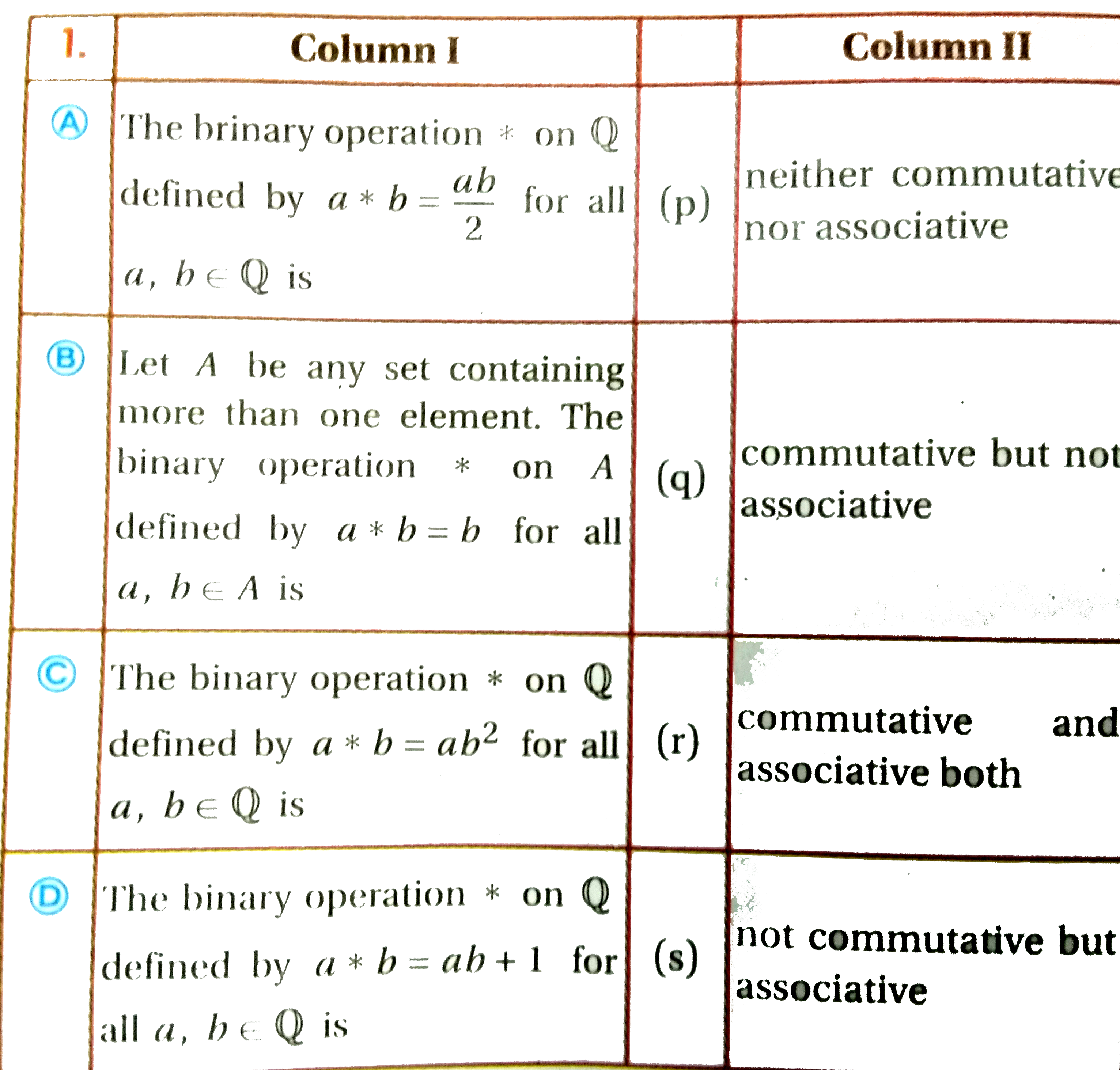Let∗ be a binary on N defined by a∗b=L.C.M.(a,b) (for alla,b∈N). 2∗4=λ then λ will be---Solution in Bengali
The correct Answer is:4
Step by step video, text & image solution for Let** be a binary on NN defined by a**b=L.C.M. (a,b) (for alla,bin NN). 2**4=lambda then lambda will be--- by Maths experts to help you in doubts & scoring excellent marks in Class 12 exams.
Updated on:21/07/2023Topper's Solved these Questions
- BINARY OPERATIONBOOK - CHHAYA PUBLICATIONCHAPTER - BINARY OPERATIONEXERCISE - Matrix Match Type
2 Videos
- BINARY OPERATIONBOOK - CHHAYA PUBLICATIONCHAPTER - BINARY OPERATIONEXERCISE - Comprehension Type
6 Videos
- BINARY OPERATIONBOOK - CHHAYA PUBLICATIONCHAPTER - BINARY OPERATIONEXERCISE - MCQs
5 Videos
- ARCHIVEBOOK - CHHAYA PUBLICATIONCHAPTER - ARCHIVEEXERCISE - JEE Advanced Archive
13 Videos
- BINOMIAL DISTRUTIONBOOK - CHHAYA PUBLICATIONCHAPTER - BINOMIAL DISTRUTIONEXERCISE - ASSERTION-REASON TYPE
2 Videos
Similar Questions
Match the following Column I and Column II

View SolutionLet A=R0×R where R0 denote the set of all non-zero real numbers. A binary operation ∗ is defined on A as follows: (a,b)∗(c,d)=(ac,bc+d) for all (a,b),(c,d)∈R0×R.
Binary operation ∗ is--
View SolutionConsider the binary operations ∗:R×R→Rand∘:R×R→R defined as a∗b=|a−b|anda∘b=a for all a,b∈R then-
View SolutionFour persons independently solve a certain problem correctly with probabilities,12,34,14,18 Then the probability that problem is solved correctly by at least one of them is-
View SolutionStatement-I: Under some condition in the random experiment, p and q are the probability of 'success' and probability of 'failure' respectively, then the probability for x success is f(x)=nCxpxqn−x(x=0,1,2,......,n)
Statement-II: Sample space of a random experiment has only two sample points one is success and other is failure.
View SolutionLet X be a nonempty set and *be a binary operation on P(X), the power set of X defined by A*B=A nn B for all A,B in P(X).(
View SolutionLet A={1,2,4,5} B={2,3,5,6}C={4,5,6,7} . Verify the following identities: A∩(B−C)=(A∩B)−(A∩C)
View Solutionमाना कि A=N×N, तथा माना कि ∗, A पर द्विआधारी संक्रिया है जो (a,b)∗(c,d)=(ad+bc,bd) सभी (a,b),(c,d)∈N×N के लिए। दिखाएँ कि
A में कोई तत्समक अवयव नहीं है।
View Solutionमाना कि ∗, N पर परिभाषित द्विआधारी संक्रिया है ताकि
a∗b=a2+b2+2, सभी a,b∈N के लिए
दिखाएँ कि 1∗2=2∗1
View SolutionLet S=N×Nand∗ is a binary operation on S defined by
(a,b)∗(c,d)=(a+c,b+d) for all a,b,c,d∈N.
Prove that ∗ is a commutative and associative binary operation on S.
View SolutionA binary ∘ on N is defined by a∘b=L.C.M.(a,b) for all a,b∈N.
(i) Examine the commutativity and associativity of ∘ on N,
(ii) Find the identity element in N,
(iii) Also find the invertible elements of N.
View SolutionThe binary operation ∗ defined on N by a∗b=a+b+ab for all a,b∈N is--
View SolutionLet ∗ be an operation defined on N, the set of natural numbers, by a∗b=L.C.M.(a,b) for all a,b∈N. Prove that ∗ is a binary operation on N.
View SolutionAn operation ∗ is defined onN as a∗b=HCF(a,b) for all a,b∈N. Show that ∗ is a binary operation on N. Find the values of 25∗15,32∗56,9∗11and34∗38.
View SolutionLet ∗ a binary operation on N given by a∗b=H.C.F(a,b) for all a,b∈N, write the value of 22∗4
View Solution
